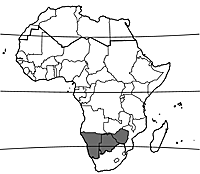Cynanchum orangeanum (PROTA)
Introduction |
| General importance | |
| Geographic coverage Africa | |
| Geographic coverage World | |
| Fruit | |
| Medicinal | |
| Food security | |
Cynanchum orangeanum (Schltr.) N.E.Br.
- Protologue: Fl. Cap. 4(1): 745 (1908).
- Family: Asclepiadaceae (APG: Apocynaceae)
- Chromosome number: × = 11
Origin and geographic distribution
Cynanchum orangeanum occurs in Namibia, Botswana, Zimbabwe and South Africa.
Uses
The Damara people in Namibia chew the roots to treat a sore throat and tonsillitis. The cut and boiled roots are taken by Jul’hoansi people to treat pain in the neck and severe coughing, including bloody sputum. A root decoction is also drunk to treat stomach-ache.
Young fruits are edible.
Properties
No phytochemical studies have been published on Cynanchum orangeanum. However, Cynanchum atratum Bunge, from northern China and Japan, is known to contain seco-pregnane steroids with antiviral properties. In Chinese medicine a root decoction of this plant is taken to treat cough and pharynchitis.
Description
Perennial herb up to 20 cm tall, with rhizome 3–7 mm in diameter; stem erect, basally woody and branched, greyish, not twining, densely to sparsely covered with trichomes; latex present. Leaves opposite, simple, entire and sessile; stipules absent; blade linear, 3–5 cm × 0.7–1.5 mm, base tapering, apex acute, margin entire, sparsely covered with erect trichomes on main veins. Inflorescence a pseudo-umbel, 1–5-flowered, all opening at the same time; peduncle 0–5 mm long. Flowers bisexual, regular, 5-merous; pedicel 3–7 mm long, with appressed trichomes; calyx with ovate lobes, 2–2.5 mm long, acute; corolla rotate, basally fused, 4–6 mm long, brown, glabrous, lobes ovate to lanceolate, incurved; corona cup-shaped, 4–5 mm long, white, lobes of staminal corona oblong, flat, reflexed, lobes of interstaminal corona filamentous, reflexed; stamens without free filaments, anthers winged and with connective appendage; ovary superior, stylar head c. 0.8 mm in diameter. Fruit consisting of a pair of fusiform follicles, each one 4–7 cm × 4–7 mm, glabrous, pale brown, strongly beaked, many-seeded. Seeds ovoid, 5–6 mm × 3–3.5 mm, dark brown, at apex bearing a coma of hairs 1.5–2 cm long.
Other botanical information
Cynanchum comprises 250–300 species worldwide. The major centre of diversity in Africa is Madagascar with approximately 90 species, minor centres of diversity are eastern Africa and southern Africa with 10–15 species each. Cynanchum orangeanum flowers from November to March. It is closely related to Cynanchum praecox Schltr. ex S.Moore, but is otherwise isolated among African Cynanchum.
Several other Cynanchum species occurring in the region are medicinally used. Cynanchum gerrardii (Harvey) Liede occurs throughout East Africa, southern Africa, the Indian Ocean islands, as well as Saudi Arabia and Yemen. In East Africa the latex is used as a fish poison. In South Africa and Somalia the young shoots are eaten as a vegetable.
Several Cynanchum species endemic to Madagascar also have medicinal uses. The bark of Cynanchum eurychitoides (K.Schum.) K.Schum. is applied to burns and is also used during circumcision rituals. A decoction of the stem and roots of Cynanchum perrieri Choux is taken against cough.
Ecology
Cynanchum orangeanum occurs on sandy, gravelly and granitic soil in grassland, at 1000–1500 m altitude.
Genetic resources
Cynanchum orangeanum is widespread but rare and localized. There are no signs that it is threatened by genetic erosion.
Prospects
Cynanchum orangeanum will probably remain of local importance as a medicinal plant.
Major references
- Boiteau, P., Boiteau, M. & Allorge-Boiteau, L., 1999. Dictionnaire des noms malgaches de végétaux. 4 Volumes + Index des noms scientifiques avec leurs équivalents malgaches. Editions Alzieu, Grenoble, France.
- Liede, S., 1996. A revision of Cynanchum (Asclepiadaceae) in Africa. Annals of the Missouri Botanical Garden 83: 283–345.
- SEPASAL, 2009. Cynanchum orangeanum. [Internet] Survey of Economic Plants for Arid and Semi-Arid Lands (SEPASAL) database. Royal Botanic Gardens, Kew, Richmond, United Kingdom. http://www.kew.org/ ceb/sepasal/. July 2009.
- von Koenen, E., 2001. Medicinal, poisonous and edible plants in Namibia. Klaus Hess Verlag, Göttingen, Germany. 336 pp.
Other references
- Albers, F. & Meve, U. (Editors), 2002. Illustrated handbook of succulent plants. Asclepiadaceae. Springer, Berlin, Heidelberg, Germany. 318 pp.
- Li, Y.M., Wang, L.H., Li, S.L., Chen, X.Y., Shen, Y.M., Zhang, Z.K., He, H.P., Xu, W.B., Shu, Y.L., Liang, G.D., Fang, R.X. & Hao, X.J., 2007. Seco-pregnane steroids target the subgenomic RNA of alphavirus-like RNA viruses. Proceedings of the National Academy of Sciences of the United States of America 104(19): 8083–8088.
- Liede, S., 1993. A taxonomic revision of the genus Cynanchum L. (Asclepiadaceae) in southern Africa. Botanische Jahrbücher 114: 503–550.
- Lovatianaharisoa, F.H., 1994. Morbidité et phytothérapie: étude faite sur les enfants dans la région Nord de Fihaonana, village d’Ambatoharanana, d’Ambohibary et de Betsitaisaina. Thèse pour l'obtention du grade de Docteur en médecine, Etablissement d'Enseignement Supérieur des Sciences de la Santé, Faculté de Médecine Université d'Antananarivo, Madagascar. 58 pp.
- Rafidison, V.M., 1999. Valorisation des plantes les plus exploitées dans la zone périphérique de la réserve naturelle intégrale d’Andohahela (Cas des villages de Ebaketra et Ihazofotsy-Bevia). Mémoire de DEA, Département Ecologie Végétale, faculté des Sciences, Université d’Antananarivo, Madagascar. 86 pp.
Author(s)
- G.H. Schmelzer, PROTA Network Office Europe, Wageningen University, P.O. Box 341, 6700 AH Wageningen, Netherlands
Correct citation of this article
Schmelzer, G.H., 2010. Cynanchum orangeanum (Schltr.) N.E.Br. In: Schmelzer, G.H. & Gurib-Fakim, A. (Editors). PROTA (Plant Resources of Tropical Africa / Ressources végétales de l’Afrique tropicale), Wageningen, Netherlands. Accessed 31 May 2025.
- See the Prota4U database.

